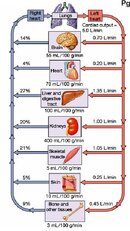In the thread about which deco stops to miss, a few people said they would keep the deep stops and shorten the shallow ones, because the CNS system is a fast-loading tissue, that will clear on the deep stops. The aim is to avoid a CNS hit.
Elsewhere I have read that the notion of 'tissues' is purely theoretical, and the phrase 'tissue compartments' should not be taken as referring to specific kinds of tissue in the body.
So now I'm confused - can anyone clarify things for me?
The reason we use mathematical modeling when discussing DCS is because the underlying causes of DCS are complex, dynamic, and not completely understood. What we do have a reasonable handle on is the risk factors and the symptoms. The concept of "fast tissues" vs "slow tissues" really only serves to describe the manner in which various parts of our body absorb and dispel dissolved gases ... and those will vary from day to day and dive to dive. In effect, our body is about as complex as the weather, and as difficult to predict how it's going to behave on any given day. Mathematical models only serve to help us descibe the process in ways that we can relate to.
A lot of people on Scubaboard tends to forget that the theory is only theory.
The mountains of data and evidence show however that it is best to follow prescribed decompression plans as closely as possible without variance.
Only for those who don't understand what they're doing. Those decompression plans are nothing more than mathematical models based on a set of assumptions that may or may not apply to a given individual. People who tech dive regularly (and DO understand what they're doing) will use those decompression plans as a starting point, and will adjust them on subsequent dives based on how they feel after a given dive. Most deco plans will allow you to modify the ascent profile simply by adding or subtracting a "conservatism" factor. Choosing a conservatism factor is completely a matter of understanding both your own body and your general predispositions to risk (e.g. age, fitness, physical state on the day of the dive, cold water, etc.).
You avoid CNS tox by (1) planning your O2 exposure properly and (2) taking 5 min "air" breaks every 15 mins while on pure O2. Even though most divers do not bring "air" with them on technical dives, there is normally a mix in the range of 20% or 21% oxygen which works suitably as if air, or else backgas works fine too.
This however has nothing to do with a "type 1 vs type 2" hit.
Type 1 means flu-like symptoms related to DCS.
Type 2 means pain or paralysis related to DCS.
CNS Ox Tox is neither a Type 1 nor Type 2 hit in the common vernacular. CNS Ox Tox is "toxing" or "a CNS hit."
Symptoms for a Type 1 or Type 2 hit are variable, and will depend on both the affected type of tissue and the severity of the blockage.
Basically a Type 1 hit is one that affects muscles or joints. The most common symptom will be excessive fatigue, pain or tingling. Depending on where the hit takes place and the severity of it, symptoms can also be flu-like symptoms, dizziness, coughing or skin rashes.
Type 2 hits are affect areas of our pulmonary, circulatory or nervous systems (those areas in our body that will absorb, diffuse, and dispel absorbed gases the quickest). These are far more serious and more difficult to treat than Type 1 hits, which is why you want to avoid them if at all possible. Symptoms can be anything from shortness of breath, lost of muscle control, convulsions, paralysis, unconsciousness, or death.
The primary reason we want to do deep stops is because our lungs will act as a pretty effective "bubble trap", reducing the risk of this type of DCS if we allow it to operate within the parameters it was designed for. Stopping for a minute or so at deeper depths gives our pulmonary and circulatory systems a chance to "catch up" and release the dispelled gases in a manner they're designed to handle before we move upward, which will increase the offgasing rate with reduced pressure.
Your deep stops are normally of 1 min duration. A deep stop is normally any stop on back-gas. Longer than this and you are simply taking on too much additional nitrogen and helium. Shorter than this and you are exceeding the 2:1 decompression gradient tolerance of body fluids and tissues.
Your helitrox stops are normally 2 to 3 mins.
Your nitrox stops are normally 3 to 5 mins.
Your 100% O2 time is then whatever it takes to establish a tissue gradient to allow you to surface within the 2:1 safety ratio. But however long you are breathing 100% O2, you should switch every 15 mins to TMX 21/XX or TMX 20/XX for 5 mins, or whatever backgas you have brought with you.
Your stops should be purely based on the depth and bottom time of your dive. You should also consider any predisposing factors, such as those mentioned previously, by having a basic understanding of how they can reduce your body's ability to offgas effectively.
Do not ever shortcut prescribed deco stops or shorten the times.

Unless, of course, the alternative is worse than DCS. A couple things that would cause me to decide the risk of DCS was worth it would be drowning or extreme hypothermia (e.g. you flooded your drysuit and are starting to shiver to the point where you're in danger of losing muscle control).
All of the above is, of course, a simplification ... but adequate for most divers.
... Bob (Grateful Diver)






